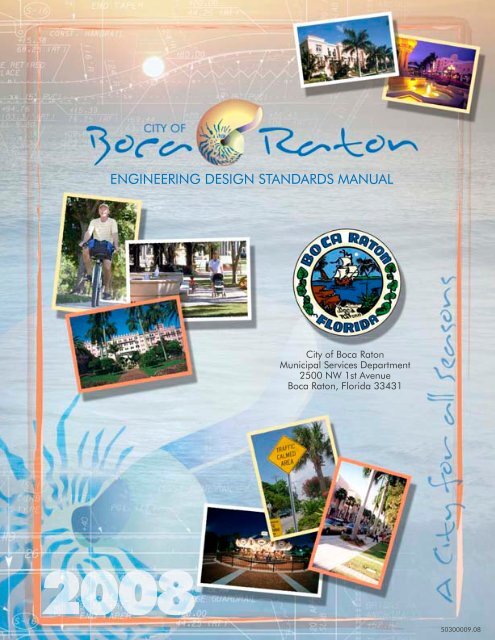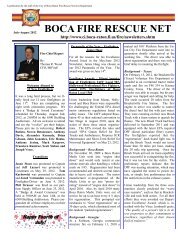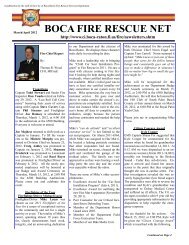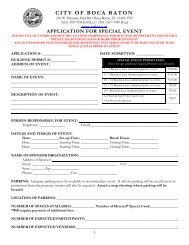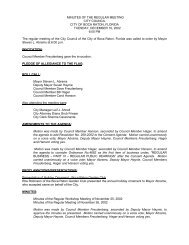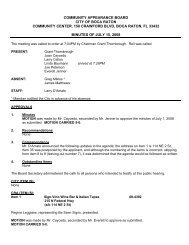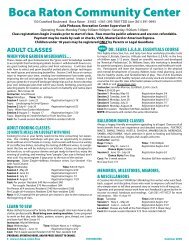ENGINEERING DESIGN STANDARDS MANUAL - City of Boca Raton
ENGINEERING DESIGN STANDARDS MANUAL - City of Boca Raton
ENGINEERING DESIGN STANDARDS MANUAL - City of Boca Raton
You also want an ePaper? Increase the reach of your titles
YUMPU automatically turns print PDFs into web optimized ePapers that Google loves.
<strong>ENGINEERING</strong> <strong>DESIGN</strong> <strong>STANDARDS</strong> <strong>MANUAL</strong><br />
<strong>City</strong> <strong>of</strong> <strong>Boca</strong> <strong>Raton</strong><br />
Municipal Services Department<br />
2500 NW 1st Avenue<br />
<strong>Boca</strong> <strong>Raton</strong>, Florida 33431<br />
50300009.08
CITY OF BOCA RATON FLORIDA<br />
Engineering Design Standards Manual<br />
2008<br />
<strong>City</strong> <strong>of</strong> <strong>Boca</strong> <strong>Raton</strong><br />
Municipal Services Department<br />
2500 NW 1 st Avenue<br />
<strong>Boca</strong> <strong>Raton</strong> Florida, 33431
Contents<br />
1.0 INTRODUCTION ..................................................................................................................................................... 3<br />
2.0 POLICY ........................................................................................................................................................................ 3<br />
2.1 SPECIAL EXEMPTION TO THE CITY OF BOCA RATON <strong>ENGINEERING</strong> <strong>DESIGN</strong> <strong>STANDARDS</strong> ..................... 3<br />
3.0 OBJECTIVES .............................................................................................................................................................. 4<br />
4.0 DEFINITIONS ............................................................................................................................................................. 5<br />
5.0 DRAFTING <strong>STANDARDS</strong>, ABBREVIATIONS AND SYMBOLS .......................................................................... 11<br />
6.0 REFERENCE <strong>MANUAL</strong>S ......................................................................................................................................... 11<br />
7.0 CONSTRUCTION PLAN REQUIREMENTS .......................................................................................................... 13<br />
8.0 STANDARD SPECIFICATIONS FOR ROAD AND BRIDGE CONSTRUCTION ............................................... 14<br />
9.0 ROADWAY TYPICAL SECTIONS .......................................................................................................................... 15<br />
FIGURE 9.1 SAMPLE TYPICAL SECTION............................................................................................................................ 17<br />
10.0 PAVEMENT <strong>DESIGN</strong> ............................................................................................................................................. 18<br />
FIGURE 10.1 CURB & GUTTER DETAILS .......................................................................................................................... 20<br />
FIGURE 10.2 PAVING DETAIL .......................................................................................................................................... 21<br />
11.0 HARBORS, DOCKS, BULKHEADS AND SEAWALLS........................................................................................ 22<br />
12.0 LIVABLE COMMUNITIES .................................................................................................................................... 22<br />
FIGURE 12.1 PARKING LOT MINIMUM <strong>STANDARDS</strong> .......................................................................................................... 24<br />
FIGURE 12.2 PARKING STRUCTURE DIMENSION <strong>STANDARDS</strong> ........................................................................................... 25<br />
FIGURE 12.3 PARKING STALL DIMENSIONS...................................................................................................................... 26<br />
FIGURE 12.4 HANDICAPPED PARKING STALL DIMENSIONS ............................................................................................... 27<br />
FIGURE 12.5 PARKING STRUCTURE DIMENSION <strong>STANDARDS</strong> ............................................................................................ 28<br />
FIGURE 12.6 PARKING STRUCTURE DIMENSION <strong>STANDARDS</strong> ............................................................................................ 29<br />
FIGURE 12.7 BICYCLE & PEDESTRIAN CIRCULATION CONCEPTUAL LAYOUT .................................................................... 30<br />
FIGURE 12.8 NEO-TRADITIONAL <strong>DESIGN</strong> <strong>STANDARDS</strong> (PRIVATE ROADS W/ ALLEYS) ........................................................ 31<br />
FIGURE 12.9 NEO-TRADITIONAL <strong>DESIGN</strong> <strong>STANDARDS</strong> (PRIVATE ROADS W/ 44’ SECTION) ................................................ 32<br />
FIGURE 12.10 NEO-TRADITIONAL <strong>DESIGN</strong> <strong>STANDARDS</strong> (PRIVATE ROADS W/ 32’ SECTION) .............................................. 33<br />
FIGURE 12.11 INVERTED CROWN ALLEY ........................................................................................................................ 34<br />
13.0 STREET <strong>DESIGN</strong>ATION ........................................................................................................................................ 35<br />
FIGURE 13.1 STREET AND ROAD <strong>DESIGN</strong>ATIONS .............................................................................................................. 36<br />
14.0 DRAINAGE .............................................................................................................................................................. 37<br />
FIGURE 14.1 PAVEMENT REPAIRS FOR OPEN CUTS........................................................................................................... 38<br />
15.0 OTHER ROADSIDE APPENDITURES ................................................................................................................. 39<br />
FIGURE 15.1 DUMPSTER ENCLOSURE – COMMERCIAL (SINGLE) ....................................................................................... 41<br />
FIGURE 15.2 DUMPSTER ENCLOSURE – RESIDENTIAL (SINGLE) ........................................................................................ 42<br />
FIGURE 15.3 DUMPSTER ENCLOSURE – TWO CUBIC YARD LOAD ..................................................................................... 43<br />
FIGURE 15.4 LOCATION OF MAILBOXES WITHIN PUBLIC RIGHT-OF-WAY .......................................................................... 44<br />
FIGURE 15.5 LOCATION OF ROADWAY MARKERS @ FILLETS (WITHIN PUBLIC R/W) ......................................................... 45<br />
FIGURE 15.6 MAILBOX DETAIL ....................................................................................................................................... 46<br />
FIGURE 15.7 PERMANENT REFERENCE MONUMENT ......................................................................................................... 47<br />
FIGURE 15.8 BICYCLE PARKING DETAIL .......................................................................................................................... 48<br />
FIGURE 15.9 TURNING RADIUS <strong>STANDARDS</strong> .................................................................................................................... 49<br />
- 1 -
FIGURE 15.10 T-TURNAROUND ....................................................................................................................................... 50<br />
FIGURE 15.11 CUL-DE-SAC – 50’ R/W (100’ DIA) W/ MOUNTABLE GUTTER ..................................................................... 51<br />
FIGURE 15.12 CUL-DE-SAC – 50’ R/W (100’ DIA) W/ MOUNTABLE GUTTER ..................................................................... 52<br />
16.0 LOCATION OF UTILITIES WITHIN CITY STREETS AND ROADS ................................................................ 53<br />
FIGURE 16.1 UTILITY LOCATION IN R/W AND EASEMENT ................................................................................................ 54<br />
FIGURE 16.2 UTILITY PLACEMENT IN 10’ EASEMENT ....................................................................................................... 55<br />
FIGURE 16.3 UTILITY PLACEMENT IN 12’ EASEMENT ....................................................................................................... 56<br />
17.0 DRIVEWAYS ........................................................................................................................................................... 57<br />
FIGURE 17.1 PAVER BLOCK DRIVEWAY (RESIDENTIAL) ................................................................................................... 58<br />
FIGURE 17.2 DRIVEWAY RESIDENTIAL ............................................................................................................................ 59<br />
FIGURE 17.3 CONCRETE DRIVEWAY FLARED APRON ....................................................................................................... 60<br />
FIGURE 17.4 ASPHALT DRIVEWAY - COMMERCIAL .......................................................................................................... 61<br />
FIGURE 17.5 ASPHALT DRIVEWAY AND DEPRESSED SIDEWALK – RESIDENTIAL R/W WIDTH OVER 60’ .............................. 62<br />
FIGURE 17.6 HEADER CURB DETAILS .............................................................................................................................. 63<br />
FIGURE 17.7 SIDEWALK CONSTRUCTION ......................................................................................................................... 64<br />
18.0 TRAFFIC CALMING .............................................................................................................................................. 65<br />
FIGURE 18.1 SPEED HUMP STANDARD SIGNING AND PAVEMENT MARKING DETAIL .......................................................... 66<br />
FIGURE 18.2 SPEED HUMP <strong>STANDARDS</strong> ........................................................................................................................... 67<br />
19.0 ROADWAY LIGHTING CRITERIA ...................................................................................................................... 68<br />
- 2 -
1.0 INTRODUCTION<br />
The purpose <strong>of</strong> this Manual is to establish uniform minimum standards for the design and construction<br />
<strong>of</strong> required improvements acceptable to the <strong>City</strong> <strong>of</strong> <strong>Boca</strong> <strong>Raton</strong>. The standards established by this<br />
Manual are applicable to all new development. While it may not always be feasible to apply these<br />
standards to reconstruction or upgrading <strong>of</strong> existing infrastructure due to limitations imposed by existing<br />
structures, ownership, and land use, these standards will be applied to the extent that legal, economic<br />
and environmental considerations allow. It should be noted that deviations from the minimum standards<br />
set forth in this manual may be granted on a case by case basis upon approval <strong>of</strong> the <strong>City</strong> Engineer.<br />
Such deviations shall be based upon specific detailed situations that are clearly justified resulting in<br />
preferable environmental impacts and such deviations are not detrimental to the public welfare, or<br />
injurious to property or improvements in the surrounding area.<br />
2.0 POLICY<br />
<strong>City</strong> <strong>of</strong> <strong>Boca</strong> Ordinances provides that the <strong>City</strong>’s Municipal Services Director shall establish and<br />
maintain the engineering design standards manual and such other standards for work within the public<br />
rights-<strong>of</strong>-way.<br />
As defined in Chapter 26 <strong>of</strong> the <strong>City</strong> <strong>of</strong> <strong>Boca</strong> Ordinances, the Engineering design standards<br />
manual is defined as:<br />
"Engineering design standards manual" shall mean the comprehensive set <strong>of</strong> specifications maintained<br />
and updated by the city for governing the minimum requirements for the design and construction <strong>of</strong><br />
engineering works such as, but not limited to, streets, roads and highways; sidewalks; filling and<br />
grading; excavating; harbors and docks; bulkheads and seawalls; drainage installations and structures;<br />
water control work and water supply; paving installations; curbs and gutters, bridges, overpasses and<br />
underpasses; underground sewage collection and disposal systems; underground utility lane line<br />
assignment; levees, pumping stations and similar works, which is on file in the city.<br />
The Engineer <strong>of</strong> Record (EOR) is responsible for the quality control <strong>of</strong> the plans and specifications. The<br />
EOR is responsible to safeguard the life, health, property and welfare <strong>of</strong> the public by promoting proper<br />
conduct in the practice <strong>of</strong> engineering and due care and regard for acceptable engineering principles and<br />
standards.<br />
The <strong>City</strong> does not warrant that any design that is review and concurred by the <strong>City</strong> staff meets or<br />
exceeds standards <strong>of</strong> the <strong>City</strong> or engineering industry.<br />
2.1 SPECIAL EXEMPTION TO THE CITY OF BOCA RATON <strong>ENGINEERING</strong><br />
<strong>DESIGN</strong> <strong>STANDARDS</strong><br />
Property annexed by the <strong>City</strong> <strong>of</strong> <strong>Boca</strong> <strong>Raton</strong> after January 1, 2003 shall continue to be allowed to follow<br />
the Palm Beach County Land Development code.<br />
- 3 -
3.0 OBJECTIVES<br />
The planning, design, construction, reconstruction, maintenance, and operation <strong>of</strong> streets and highways<br />
should be predicated upon meeting the following objectives:<br />
� Develop and maintain a highway system that provides the safest practicable environment for<br />
motorists, cyclists, pedestrians, and workers.<br />
� Establish and maintain procedures for construction, maintenance, utility, and emergency<br />
operations that provide for safe highway and transit operating conditions during these activities.<br />
� Provide streets and highways with operating characteristics that allow for reasonable limitations<br />
upon the capabilities <strong>of</strong> vehicles, drivers, cyclists, pedestrians, and workers.<br />
� Provide uniformity and consistency in the design and operation <strong>of</strong> streets and highways.<br />
� Provide for satisfactory resolution <strong>of</strong> conflicts between the surface transportation system and<br />
social and environmental considerations to aid neighborhood integrity.<br />
� Reconstruct or modify existing facilities to reduce the hazard to the highway users.<br />
� Reduce the deaths, injuries, and damage due to highway crashes.<br />
- 4 -
4.0 DEFINITIONS<br />
For definitions <strong>of</strong> elements associated with public works, refer to the <strong>MANUAL</strong> OF UNIFORM<br />
MINIMUM <strong>STANDARDS</strong> FOR <strong>DESIGN</strong>, CONSTRUCTION AND MAINTENANCE FOR<br />
STREETS AND HIGHWAYS (Commonly known as the "Florida Greenbook") latest edition.<br />
The following abbreviations listed:<br />
AASHTO.<br />
“A Policy on Geometric Design <strong>of</strong> Highways and Streets” published by The American Association <strong>of</strong><br />
State Highway and Transportation Officials, and updated time to time.<br />
Architect.<br />
The Architect as defined in s.481.203(3) Florida Statutes.<br />
Architect <strong>of</strong> Record.<br />
The Architect or Architectural Firm registered in the State <strong>of</strong> Florida that performs services for<br />
the Department in connection with the design and construction <strong>of</strong> buildings.<br />
Architecture.<br />
The practice <strong>of</strong> architecture as defined in s.481.203(6) Florida Statutes.<br />
Article.<br />
The numbered prime subdivision <strong>of</strong> a Section <strong>of</strong> the FDOT Specifications.<br />
Bidder.<br />
An individual, firm, or corporation submitting a proposal for the proposed work.<br />
Bridge.<br />
A structure, including supports, erected over a depression or over an obstruction such as water,<br />
highway or railway, or for elevated roadway, for carrying traffic or other moving loads, and having a<br />
length, measured along the center <strong>of</strong> the roadway, <strong>of</strong> more than 20 feet [6 m] between the inside faces <strong>of</strong><br />
end supports. A multiple-span box culvert is considered a bridge, where the length between the extreme<br />
ends <strong>of</strong> the openings exceeds 20 feet [6 m].<br />
Calendar day.<br />
Every day shown on the calendar, ending and beginning at midnight.<br />
<strong>City</strong>.<br />
<strong>City</strong> <strong>of</strong> <strong>Boca</strong> <strong>Raton</strong>.<br />
<strong>City</strong> Engineer.<br />
The <strong>City</strong> <strong>of</strong> <strong>Boca</strong> Engineer, or appointed person by the Director <strong>of</strong> the <strong>City</strong> <strong>of</strong> <strong>Boca</strong> <strong>Raton</strong><br />
Municipal Services Department; acting directly or through duly authorized representatives; such<br />
representatives acting within the scope <strong>of</strong> the duties and authority assigned to them.<br />
- 5 -
Consultant.<br />
The Pr<strong>of</strong>essional Engineer or Engineering Firm, or the Architect or Architectural Firm,<br />
registered in the State <strong>of</strong> Florida and under contract to the Owner to perform pr<strong>of</strong>essional services. The<br />
consultant may be the Engineer or Architect <strong>of</strong> Record or may provide services through and be<br />
subcontracted to the Engineer or Architect <strong>of</strong> Record.<br />
Contract.<br />
The term “Contract” means the entire and integrated agreement between the parties thereunder<br />
and supersedes all prior negotiations, representations, or agreements, either written or oral. The Contract<br />
Documents form the Contract between the Owner and the Contractor setting forth the obligations <strong>of</strong> the<br />
parties thereunder, including, but not limited to, the performance <strong>of</strong> the Work and the basis <strong>of</strong> payment.<br />
Contractor.<br />
The individual, firm, joint venture, or company contracting with the Owner to perform work.<br />
County Standards.<br />
The standards and details set forth by Palm Beach County Engineering division.<br />
Culverts.<br />
Any structure not classified as a bridge that provides an opening under the roadway.<br />
Department or FDOT.<br />
State <strong>of</strong> Florida Department <strong>of</strong> Transportation.<br />
Designer <strong>of</strong> Record.<br />
The Architect <strong>of</strong> Record or the Engineer <strong>of</strong> Record.<br />
Downtown.<br />
As defined in the <strong>City</strong> <strong>of</strong> <strong>Boca</strong> <strong>Raton</strong> Development Order No. 4035 - RULES OF THE BOCA<br />
RATON COMMUNITY REDEVELOPMENT AGENCY.<br />
Engineer <strong>of</strong> Record.<br />
The Pr<strong>of</strong>essional Engineer or Engineering Firm registered in the State <strong>of</strong> Florida per State<br />
Statutes, that develops the criteria and concept for the project, performs the analysis, and is responsible<br />
for the preparation <strong>of</strong> the Plans and Specifications.<br />
Equipment.<br />
The machinery and equipment, together with the necessary supplies for upkeep and maintenance<br />
there<strong>of</strong>, and all other tools and apparatus necessary for the construction and acceptable completion <strong>of</strong> the<br />
work.<br />
Extra Work.<br />
Any “work” which is required by the Engineer to be performed and which is not otherwise<br />
covered or included in the project by the existing Contract Documents, whether it be in the nature <strong>of</strong><br />
additional work, altered work, deleted work, work due to differing site conditions, or otherwise. This<br />
term does not include a “delay”.<br />
FDOT.<br />
Florida Department <strong>of</strong> Transportation<br />
- 6 -
FDOT Standards.<br />
Design Standards for Design, Construction, maintenance and utility operations on the state<br />
highway system, latest edition booklet published by the Florida Department <strong>of</strong> Transportation and<br />
update time to time.<br />
FHWA.<br />
Federal Highway Administration<br />
Greenbook.<br />
The Manual <strong>of</strong> Uniform Minimum Standards for Design, Construction and Maintenance for<br />
Streets and Highways <strong>of</strong> the State <strong>of</strong> Florida as promulgated and revised from time to time by the<br />
Florida Department <strong>of</strong> Transportation, Latest edition.<br />
Highway, Street, or Road.<br />
A general term denoting a public way for purposes <strong>of</strong> vehicular travel, including the entire area<br />
within the right-<strong>of</strong>-way.<br />
Holidays.<br />
Days designated by the State Legislature or Cabinet as holidays, which include, but are not<br />
limited to, New Year’s Day, Martin Luther King’s Birthday, Memorial Day, Independence Day, Labor<br />
Day, Veterans’ Day, Thanksgiving Day and the following Friday, and Christmas Day.<br />
Inspector.<br />
An authorized representative <strong>of</strong> the Engineer, assigned to make <strong>of</strong>ficial inspections <strong>of</strong> the<br />
materials furnished and <strong>of</strong> the work performed by the Contractor.<br />
Laboratory.<br />
The <strong>of</strong>ficial testing laboratory used by the Contractor or Engineer.<br />
Materials.<br />
Any substances to be incorporated in the work under the Contract.<br />
Median.<br />
The portion <strong>of</strong> a divided highway or street separating the traveled ways for traffic moving in<br />
opposite directions.<br />
MUTCD.<br />
Manual <strong>of</strong> Uniform Traffic Control Devices latest edition published by FHWA.<br />
Plans.<br />
The approved plans, including reproductions there<strong>of</strong>, showing the location, character,<br />
dimensions, and details <strong>of</strong> the work.<br />
Proposal (Bid, Bid Proposal).<br />
The <strong>of</strong>fer <strong>of</strong> a bidder, on the prescribed form, to perform the work and to furnish the labor and<br />
materials at the prices quoted.<br />
- 7 -
Proposal Form.<br />
The <strong>of</strong>ficial form or the expedite program generated bid item sheets on which the Department<br />
requires formal bids to be prepared and submitted for the work.<br />
Proposal Guaranty<br />
The security furnished by the bidder as guaranty that the bidder will enter into the Contract for<br />
the work if the Department accepts the proposal.<br />
Right-<strong>of</strong>-Way.<br />
The land that the <strong>City</strong> or Department has title to, or right <strong>of</strong> use, for the road and its structures<br />
and appurtenances, and for material pits furnished by the Department.<br />
Roadbed.<br />
The portion <strong>of</strong> the roadway occupied by the subgrade and shoulders.<br />
Roadway.<br />
The portion <strong>of</strong> a highway within the limits <strong>of</strong> construction.<br />
Secretary.<br />
Secretary <strong>of</strong> Transportation, State <strong>of</strong> Florida Department <strong>of</strong> Transportation, acting directly or<br />
through an assistant or other representative authorized by him; the chief <strong>of</strong>ficer <strong>of</strong> the Department <strong>of</strong><br />
Transportation.<br />
Section.<br />
A numbered prime division <strong>of</strong> FDOT Specifications.<br />
Special Provisions.<br />
See definition for Specifications.<br />
Specialty Engineer.<br />
A Pr<strong>of</strong>essional Engineer registered in the State <strong>of</strong> Florida, other than the Engineer <strong>of</strong> Record or<br />
his subcontracted consultant, who undertakes the design and drawing preparation <strong>of</strong> components,<br />
systems, or installation methods and equipment for specific portions <strong>of</strong> the project work. The Specialty<br />
Engineer may be an employee or <strong>of</strong>ficer <strong>of</strong> the Contractor or a fabricator, an employee or <strong>of</strong>ficer <strong>of</strong> an<br />
entity providing components to a fabricator, or an independent consultant.<br />
The Specialty Engineer must be qualified in accordance with the Rules <strong>of</strong> the Department <strong>of</strong><br />
Transportation, Chapter 14-75. Any Corporation or Partnership <strong>of</strong>fering engineering services must hold<br />
a Certificate <strong>of</strong> Authorization from the Florida Department <strong>of</strong> Business and Pr<strong>of</strong>essional Regulation.<br />
For items <strong>of</strong> work not specifically covered by the Rules <strong>of</strong> the Department <strong>of</strong> Transportation, a<br />
Specialty Engineer is qualified if he has the following qualifications:<br />
(1) Registration as a Pr<strong>of</strong>essional Engineer in the State <strong>of</strong> Florida.<br />
(2) The education and experience necessary to perform the submitted design as required<br />
by the Florida Department <strong>of</strong> Business and Pr<strong>of</strong>essional Regulation.<br />
Specifications.<br />
The directions, provisions, and requirements contained herein, together with all stipulations<br />
contained in the Contract Documents, setting out or relating to the method and manner <strong>of</strong> performing the<br />
work, or to the quantities and qualities <strong>of</strong> materials and labor to be furnished under the Contract.<br />
- 8 -
A. Standard Specifications: “Standard Specifications for Road and Bridge Construction”<br />
a bound book, applicable to all Department Contracts containing adopted requirements, setting out or<br />
relating to the method or manner <strong>of</strong> performing work, or to the quantities and qualities <strong>of</strong> materials and<br />
labor.<br />
B. Supplemental Specifications: Approved additions and revisions to the Standard<br />
Specifications, applicable to all Department Contracts.<br />
C. Special Provisions: Specific clauses adopted by the Department that add to or revise<br />
the Standard Specifications or supplemental specifications, setting forth conditions varying from or<br />
additional to the Standard Specifications applicable to a specific project.<br />
D. Technical Special Provisions: Specifications, <strong>of</strong> a technical nature, prepared, signed,<br />
and sealed by an Engineer registered in the State <strong>of</strong> Florida other than the State Specifications Engineer<br />
or his designee, that are made part <strong>of</strong> the Contract as an attachment to the Contract Documents.<br />
Standard Specifications.<br />
See definition for Specifications.<br />
State.<br />
State <strong>of</strong> Florida.<br />
Subgrade.<br />
The portion <strong>of</strong> the roadbed immediately below the base course or pavement, including below the<br />
curb and gutter, valley gutter, shoulder and driveway pavement. The subgrade limits ordinarily include<br />
those portions <strong>of</strong> the roadbed shown in the plans to be constructed to a design bearing value or to be<br />
otherwise specially treated. Where no limits are shown in the plans, the subgrade section extends to a<br />
depth <strong>of</strong> 12 inches [300 mm] below the bottom <strong>of</strong> the base or pavement and outward to 6 inches<br />
[150 mm] beyond the base, pavement, or curb and gutter.<br />
Substructure.<br />
All <strong>of</strong> that part <strong>of</strong> a bridge structure below the bridge seats, including the parapets, backwalls,<br />
and wingwalls <strong>of</strong> abutments.<br />
Superintendent.<br />
The Contractor’s authorized representative in responsible charge <strong>of</strong> the work.<br />
Superstructure.<br />
The entire bridge structure above the substructure, including anchorage and anchor bolts, but<br />
excluding the parapets, backwalls, and wingwalls <strong>of</strong> abutments.<br />
Supplemental Specifications<br />
See definition for Specifications.<br />
Technical Special Provisions.<br />
See definition for Specifications.<br />
Traveled Way.<br />
The portion <strong>of</strong> the roadway providing for the movement <strong>of</strong> vehicles, exclusive <strong>of</strong> shoulders and<br />
auxiliary lanes.<br />
- 9 -
Work.<br />
All labor, materials and incidentals required to execute and complete the requirements <strong>of</strong> the<br />
Contract including superintendence, use <strong>of</strong> equipment and tools, and all services and responsibilities<br />
prescribed or implied.<br />
Working Day.<br />
Any calendar day on which the Contractor works or is expected to work in accordance with the<br />
approved work progress schedule.<br />
WUD Standards.<br />
The <strong>City</strong> <strong>of</strong> <strong>Boca</strong> <strong>Raton</strong> Water Utilities Department's Manual <strong>of</strong> Minimum Engineering and<br />
Construction Standards.<br />
- 10 -
5.0 Drafting Standards, Abbreviations and Symbols<br />
The Contract plans set and specifications are the key documents for a project construction and on which<br />
ultimately, the <strong>City</strong> will based their review, and the contractor will base their bid and work on. Hence, it<br />
is imperative that the contract plans and specifications set forth the work to be done in a clear and<br />
concise manner.<br />
The EOR is responsible to assure that the existing and proposed information on the plans is accurate.<br />
Standard Abbreviations and Symbols used for plans preparation and permit drawings with the <strong>City</strong> <strong>of</strong><br />
<strong>Boca</strong> <strong>Raton</strong> shall conform to the standard Abbreviations and symbols are shown in Indices 001 and 002<br />
<strong>of</strong> the Florida Department <strong>of</strong> Transportation Design Standards for Design, Construction Maintenance<br />
and Utility operations on the State Highway system latest edition.<br />
When deemed necessary by the <strong>City</strong> Civil engineer, for the clarification <strong>of</strong> special symbols or<br />
abbreviations, the plans shall provide a supplemental legend as required.<br />
6.0 REFERENCE <strong>MANUAL</strong>S<br />
By reference, the following is made part <strong>of</strong> this manual:<br />
1) Highway Capacity Manual – latest edition as published by the Transportation Research<br />
Board.<br />
2) Manual on Uniform Traffic Control Devices for Streets and Highways, U.S. Department <strong>of</strong><br />
Transportation, Federal Highway Administration, latest edition. (Developed with<br />
cooperation <strong>of</strong> the National Advisory Committee on Uniform Traffic Control Devices.)<br />
3) A Policy on Design on Geometric Design <strong>of</strong> Highways and Streets, 2004. American<br />
Association <strong>of</strong> State Highway and Transportation Officials.<br />
4) Transportation and Traffic Engineering Handbook, Institute <strong>of</strong> Transportation Engineers.<br />
5) Roadside Design Guide, latest Edition. American Association <strong>of</strong> State Highway and<br />
Transportation Officials.<br />
6) Manual <strong>of</strong> Uniform Minimum Standards for Design, Construction and Maintenance for<br />
Streets and Highways, State <strong>of</strong> Florida, The Florida Department <strong>of</strong> Transportation, latest<br />
edition.<br />
- 11 -
7) Traffic Engineering Manual, The Florida Department <strong>of</strong> Transportation.<br />
8) Design Standards for Design, Construction, Maintenance and Utility Operations on the State<br />
Highway System, latest edition, The Florida Department <strong>of</strong> Transportation.<br />
9) <strong>City</strong> <strong>of</strong> <strong>Boca</strong> <strong>Raton</strong> Public Utilities Manual, Latest Revision<br />
10) Parking Standards, Urban Land Institute 2002.<br />
11) The Dimensions <strong>of</strong> Parking, Urban Land Institute, latest edition.<br />
12) Utility Accommodations Manual, Florida Department <strong>of</strong> Transportation.<br />
13) Palm Beach County Land Development Code, Palm Beach County Florida.<br />
14) Code <strong>of</strong> Ordinances, <strong>City</strong> <strong>of</strong> <strong>Boca</strong> <strong>Raton</strong>.<br />
15) Guide for the Planning, Design, and Operation <strong>of</strong> Pedestrian Facilities, American Association<br />
<strong>of</strong> State Highway and Transportation Officials<br />
16) Guide for the Development <strong>of</strong> Bicycle Facilities, American Association <strong>of</strong> State Highway<br />
and Transportation Officials<br />
17) Military Handbook Seawalls, Bulkheads, and Quaywalls, US Navy<br />
NOTE: In the event <strong>of</strong> a conflict between this manual and the above referenced publications, the<br />
<strong>Boca</strong> <strong>Raton</strong> Standard will apply or as specifically directed by the <strong>City</strong> Engineer.<br />
- 12 -
7.0 CONSTRUCTION PLAN REQUIREMENTS<br />
Construction plans submitted to the <strong>City</strong> for review and approval shall be clear and understandable.<br />
Construction plans shall clearly show in scaled drawing(s) existing conditions and identify the proposed<br />
improvements <strong>of</strong> the project. The construction plans shall show all pertinent information, be consistent<br />
with practices <strong>of</strong> plans prepared by other pr<strong>of</strong>essionals within the industry and prepared to the<br />
satisfaction <strong>of</strong> the <strong>City</strong>’s Civil Engineer and/or the Chief <strong>of</strong> Design.<br />
Complete construction plans are prepared by an engineer registered in the state for the entire<br />
development <strong>of</strong> the area, together with a complete and accurate contour map using National Geodetic<br />
Vertical Datum (NGVD) and a drainage plan showing elevations <strong>of</strong> adjacent properties.<br />
Sewer and water systems shall be reviewed and approved by the city staff, and all applicable regulatory<br />
agencies. Construction plans shall include the complete design <strong>of</strong> required sanitary sewer, water supply,<br />
storm drainage and street systems for the entire area to be subdivided. Due consideration shall be given<br />
to the problems that may be created by the subdivision <strong>of</strong> adjacent lands, especially as pertains to storm<br />
drainage, in order that conformity with the overall secondary master drainage plan will be obtained. The<br />
submission <strong>of</strong> such construction plans shall be accompanied by a fee as provided in the city municipal<br />
facilities and services user fee schedule.<br />
- 13 -
8.0 STANDARD SPECIFICATIONS FOR ROAD AND BRIDGE<br />
CONSTRUCTION<br />
It should be the intent <strong>of</strong> the Engineer <strong>of</strong> Record to utilize Specifications adopted by the Florida<br />
Department <strong>of</strong> Transportation "Standard Specifications for Road and Bridge Construction" (latest<br />
edition) and the supplements thereto, be used as the basis for construction <strong>of</strong> all work and require that all<br />
work performed by a contractor within the rights <strong>of</strong> way under the jurisdiction <strong>of</strong> the <strong>City</strong> <strong>of</strong> <strong>Boca</strong> <strong>Raton</strong><br />
be constructed in compliance with said Specifications except as set forth and agreed upon by the <strong>City</strong> <strong>of</strong><br />
<strong>Boca</strong> <strong>Raton</strong>.<br />
In addition to these Standard Specifications, the Engineer <strong>of</strong> Record should stipulate Special Conditions<br />
and Special Provisions as needed, which pertain to the pertinent items <strong>of</strong> construction.<br />
The Engineer, Applicant and Contractor’s attention is directed to and prior to any excavation shall,<br />
comply with the requirements <strong>of</strong> Florida Statutes 553.851 “Protection <strong>of</strong> Underground Gas Pipelines”<br />
and 556, “Underground Facility Damage Prevention and Safety Act.”<br />
Further, that the Engineer, Applicant and Contractor’s attention is directed to and prior to<br />
commencement <strong>of</strong> construction shall comply with Palm Beach County Land Development Code, Article<br />
9, Section 9.3, D.1.d (8), “Construction Activities” and Appendix 9.3.C., “Best Management Practices,”<br />
concerning construction, repairing or maintenance <strong>of</strong> any facility, or improvement to land and the<br />
handling, storage, containment and disposal <strong>of</strong> regulated substances in zones <strong>of</strong> influence numbers 1,2,3<br />
and 4 <strong>of</strong> a (water) well.<br />
- 14 -
9.0 Roadway Typical Sections<br />
Every project that proposes improvements or modifications to a roadway or pedestrian facility under the<br />
jurisdiction <strong>of</strong> the <strong>City</strong> <strong>of</strong> <strong>Boca</strong> <strong>Raton</strong> shall be coordinated with the <strong>City</strong> Civil Engineer prior to permit<br />
submittal. This allows the <strong>City</strong> staff to be informed <strong>of</strong> the project, to identify and coordinate adjacent<br />
projects with both city <strong>of</strong>ficials and residents.<br />
Prior to engineering permit submittal, the Engineer <strong>of</strong> Record shall prepare the proposed roadway<br />
typical section(s) in a 8-1/2” x 11” typical section approval package and submit three (3) copies <strong>of</strong> the<br />
package to the <strong>City</strong> Engineer (or designee) for review and comment. The Engineer may request this<br />
preliminary review in the form <strong>of</strong> a “hands on” meeting with the <strong>City</strong> Civil Engineer, if desired.<br />
The roadway typical sections package shall clearly identify the proposed pertinent horizontal controls <strong>of</strong><br />
the project at including but limited to:<br />
1. Limits <strong>of</strong> Work<br />
2. Number and width <strong>of</strong> roadway travel lanes<br />
3. Pavement cross slopes<br />
4. Design Speed<br />
5. Roadside sideslopes and roadside treatment<br />
6. Location/type <strong>of</strong> curb and/or curb and gutters<br />
7. Location/type and width <strong>of</strong> bike facilities<br />
8. Location/type and width <strong>of</strong> sidewalks<br />
9. Proposed pavement design<br />
10. Right-<strong>of</strong>-way width<br />
11. Grass location and type.<br />
12. Location/design parameters <strong>of</strong> drainage swales<br />
13. Median type and width<br />
Multiple sections may be required to address various changes in the horizontal controls.<br />
The Engineer <strong>of</strong> Record shall ensure that the proposed typical section elements are consistent with<br />
standards shown in the Manual <strong>of</strong> Uniform Minimum Standards for Design, Construction and<br />
Maintenance for Streets and Highways, State <strong>of</strong> Florida.<br />
Typical sections for roadways under the jurisdiction <strong>of</strong> FDOT or Palm Beach County may be submitted<br />
to the <strong>City</strong> for informational purposes; however, final approval <strong>of</strong> the typical section is subject to<br />
approval <strong>of</strong> the appropriate jurisdictional agency.<br />
- 15 -
The selected design speed for the facility shall be consistent with other similar highway corridors<br />
operating in the same capacity as the project corridor. The design speed should be selected upon<br />
predicted driver behavior and based upon the probable maximum operating speed by vehicles on the<br />
street or highway. Since this may lead to interpretation <strong>of</strong> data, the Engineer <strong>of</strong> Record should consult<br />
with the <strong>City</strong> Civil Engineer on the proper design speed to be used. In no case, shall the design speed<br />
used for design be less than the posted speed limit.<br />
The exhibit shown constitutes the level <strong>of</strong> detail expected for typical section packages and does not<br />
represent acceptable criteria for all similar facilities.<br />
- 16 -
10.0 Pavement Design<br />
On streets and roadways within the jurisdiction <strong>of</strong> the <strong>City</strong> <strong>of</strong> <strong>Boca</strong> <strong>Raton</strong>, the Engineer <strong>of</strong> Record is<br />
responsible to verify that applicable sound engineering principles are used in the structural design <strong>of</strong><br />
flexible and rigid pavement systems. The Engineer must recognized that in high volume, high loading<br />
areas, the thickness <strong>of</strong> the proposed pavement system may need to be greater than the minimum to<br />
ensure an adequate service life will be reached. The Engineer <strong>of</strong> Record should coordinate this is<br />
address this with the <strong>City</strong> Civil Engineer, if consideration <strong>of</strong> thicker than minimum pavement systems<br />
should be considered for a specific area. FDOT’s Flexible Pavement Design Manual shall be used as a<br />
basis <strong>of</strong> reference.<br />
Minimum service life <strong>of</strong> new pavements shall be 20 years. The minimum service life <strong>of</strong> rehabilitated<br />
pavements shall be 10 years.<br />
The Minimum acceptable Pavement Design systems for pavements within the jurisdiction <strong>of</strong> the <strong>City</strong> are<br />
as follows:<br />
Arterials, Collector and Minor Roadways:<br />
Stabilized Subgrade 12” (LBR 40), 8” limerock base and 1.5” Type S-1 Asphaltic Concrete.<br />
Residential Driveways:<br />
Subgrade shall be firm and unyielding, 6” limerock base and 1” Type S-1 Asphaltic Concrete.<br />
Commercial Driveways:<br />
Flexible pavement - Subgrade shall be firm and unyielding, 8” limerock base and 1.5” Type S-1<br />
Asphaltic Concrete.<br />
Driveways (Residential and Comercial) with Rigid Pavments:<br />
Subgrade shall be firm and unyielding, 6” Concrete Pavement (Class I).<br />
Acceptable Substitutions:<br />
In lieu <strong>of</strong> 8” <strong>of</strong> Limerock base course, the Engineer may allow the contractor to substitute with 5” <strong>of</strong><br />
Type B-12.5 (Asphaltic Concrete Base Course).<br />
In lieu <strong>of</strong> Stabilized Subgrade (12” LBR 40), the Engineer may allow the contractor to substitute with<br />
5.5” Limerock Base Course.<br />
- 18 -
When the project proposes Type B-12.5 (Asphaltic Concrete) as the Base Course, the Stabilized<br />
Subgrade (12” LBR 40) course may be compensated with an additional 3.5” <strong>of</strong> Type B-12.5 (Asphaltic<br />
Concrete) Base Course. Thus, the 12” Stabilization (LBR 40) and 8” Limerock Base Course may be<br />
substituted with 8.5” Type B-12.5 (Asphaltic Concrete) Base Course on Subgrade that is firm and<br />
unyielding.<br />
Pavement Design <strong>of</strong> areas other than roadways:<br />
Pavement design <strong>of</strong> <strong>City</strong> maintained, non-roadway street pavements such as parking areas and<br />
maintenance aprons are to be designed to the discretion <strong>of</strong> the <strong>City</strong> Civil Engineer.<br />
- 19 -
11.0 Harbors, Docks, Bulkheads and Seawalls<br />
The design, layout <strong>of</strong> Harbors, docks, bulkheads and seawalls are recommended to be performed by<br />
experienced engineers and should be closely coordinated by the Engineer <strong>of</strong> Record with the <strong>City</strong> Civil<br />
Engineer.<br />
Boat travel in coastal waters is a public right established through the commerce clause <strong>of</strong> the U.S.<br />
Constitution which gives the Congress regulatory power over navigable waters—an authority that has<br />
been delegated to the U.S. Army Corps <strong>of</strong> Engineers (USACE).<br />
Design parameters shown in the <strong>City</strong> <strong>of</strong> <strong>Boca</strong> <strong>Raton</strong> has a Marine Structures Code and the MILITARY<br />
HANDBOOK SEAWALLS, BULKHEADS, AND QUAYWALLS, US Navy, which can be used by the<br />
engineer for reference.<br />
12.0 Livable Communities<br />
It is the policy <strong>of</strong> the <strong>City</strong> to consider Transportation Design for Livable Communities (TDLC) features<br />
on the city roadways when such features are desired, appropriate and feasible. This involves providing a<br />
balance between mobility and livability. TDLC features should be based on consideration <strong>of</strong> the<br />
following principles:<br />
1. Safety <strong>of</strong> pedestrians, bicyclists, motorists and public transit users.<br />
2. Balancing community values and mobility needs.<br />
3. Efficient use <strong>of</strong> energy resources.<br />
4. Protection <strong>of</strong> the natural and manmade environment.<br />
5. Coordinated land use and transportation planning.<br />
6. Local and state economic development goals.<br />
7. Complementing and enhancing existing design standards, systems and processes.<br />
On-street parallel parking is preferred over angled parking on low speed urban streets. Angled parking<br />
causes conflicts with cars and bicycles, since drivers have poor visibility when backing out. Parallel<br />
parking can provide space for bike lanes, medians and wider sidewalks. The design <strong>of</strong> parking facilities<br />
should be coordinated with local transit agencies.<br />
- 22 -
Curb extensions, sometimes called bulb-outs, may be used at intersections, or at mid-block locations<br />
where there is a marked crosswalk, provided there is a parking lane into which the curb may be<br />
extended. Curb extensions shorten the crossing distance, and provide additional space at intersections<br />
allowing pedestrians to see and be seen before entering a crosswalk. A curb extension is not generally<br />
used where there is no parking lane because <strong>of</strong> potential hazard to bicycle travel. The design must also<br />
take into consideration the needs <strong>of</strong> transit vehicles.<br />
Personal security and safety is promoted by maximizing visibility in and along parking areas, building<br />
entrances, transit stops, sidewalks and roadways. This can be provided by the following techniques:<br />
1. Providing lighting.<br />
2. Lowering vegetation heights.<br />
3. Removing hiding places.<br />
Examples for designing safer communities can be found in The National Crime Prevention Council’s<br />
publication: Crime Prevention Through Environmental Design.<br />
- 23 -
201 West Palmetto Park Road<br />
<strong>Boca</strong> <strong>Raton</strong>, Florida 33432<br />
REVISIONS<br />
orig.<br />
REV.<br />
REV.<br />
12-2007<br />
PARKING LOT<br />
MINIMUM <strong>STANDARDS</strong><br />
FIGURE<br />
12.1
E<br />
A<br />
PARKING STRUCTURE <strong>STANDARDS</strong><br />
B<br />
C<br />
FULL SIZE STALLS<br />
(a) 9.0 Ft x 18.0 Ft<br />
A B C D E F G<br />
H<br />
F<br />
COMPACT SIZE STALLS (DOWNTOWN ONLY)<br />
201 West Palmetto Park Road<br />
<strong>Boca</strong> <strong>Raton</strong>, Florida 33432<br />
(a) 8.0 Ft x 16.0 Ft<br />
REVISIONS<br />
orig.<br />
REV.<br />
REV.<br />
12-2007<br />
D<br />
G<br />
H<br />
Notes<br />
One-Way isle only<br />
One-Way isle only<br />
Two-Way isle Only<br />
One-Way isle only<br />
One-Way isle only<br />
Two-Way isle Only<br />
PARKING STRUCTURE<br />
DIMENSION <strong>STANDARDS</strong><br />
FIGURE<br />
12.2
13.0 Street Designation<br />
The <strong>City</strong> <strong>of</strong> <strong>Boca</strong> <strong>Raton</strong> utilizes the street and road specifications as shown on the following<br />
detail.<br />
- 35 -
14.0 Drainage<br />
All drainage structures – inlets and manholes within the city jurisdiction shall conform to the Design<br />
Standards for Design, Construction, Maintenance and Utility Operations on the State Highway<br />
System, latest edition, The Florida Department <strong>of</strong> Transportation.<br />
All drainage structure frames, covers, lids or grates that are within the city right <strong>of</strong> way shall be<br />
traffic bearing.<br />
All pipes to be maintained by the <strong>City</strong> <strong>of</strong> <strong>Boca</strong> <strong>Raton</strong> shall be concrete reinforced pipe.<br />
Installation and restoration <strong>of</strong> pavement for drainage and utility pipes in open cuts under <strong>City</strong><br />
maintained streets shall conform to the Open cut detail.<br />
- 37 -
15.0 Other Roadside Appenditures<br />
Dumpster (Figure 15.1, 15.2 & 15.3)<br />
Dumpster enclosure and design locations shall meet the requirements set forth in <strong>City</strong> <strong>of</strong> <strong>Boca</strong> <strong>Raton</strong><br />
standards.<br />
Mailboxes (Figures 15.4 & 15.6)<br />
Mailboxes installed and maintained by the owner within the right <strong>of</strong> way <strong>of</strong> the city street shall meet<br />
the general requirements <strong>of</strong> the attached Mailbox detail.<br />
� The location and construction <strong>of</strong> mailboxes shall conform to the rules and regulations <strong>of</strong> the<br />
United States Postal Service as modified by this design standard.<br />
� Wood or steel support posts for both single and double mailbox mountings shall be<br />
embedded no more than 24” into the ground.<br />
� No more than two mailboxes may be mounted on a single post.<br />
� Lightweight Plastic newspapers receptacles may be mounted below the mailbox on the side<br />
<strong>of</strong> the support in conformance with USPS Domestic Mail Manual.<br />
� Neighborhood Delivery and Collection Box Units are a specialized multiple mailbox<br />
installation that must be located outside the highway/street clear zone.<br />
� At driveway entrances, mailboxes shall be placed on the far side <strong>of</strong> the driveway in the<br />
direction <strong>of</strong> the delivery route.<br />
� No Concrete, Block, brick stone or rigid mailbox foundation structure or encasement above<br />
the ground line located within the highway /street clear zone, will be permitted.<br />
Dome buttons (Figure15.5)<br />
Residents will be allowed to install and maintain concrete domed buttons 2 feet <strong>of</strong>f the roadway<br />
pavement as shown in attached detail.<br />
Permanent Reference monuments (Figure15.7)<br />
A permanent survey reference monument is an artificial or natural object that is permanent used or<br />
presumed to occupy any real property corner, point on a boundary line, or reference point.<br />
Per Florida Statues Section 177.031 Definitions<br />
15) "P.R.M." means a permanent reference monument which must:<br />
- 39 -
(a) Consist <strong>of</strong> a metal rod having a minimum length <strong>of</strong> 18 inches and a minimum cross-section area<br />
<strong>of</strong> material <strong>of</strong> 0.2 square inches. In certain materials, encasement in concrete is optional for stability<br />
<strong>of</strong> the rod. When used, the concrete shall have a minimum cross-section area <strong>of</strong> 12.25 square inches<br />
and be a minimum <strong>of</strong> 24 inches long.<br />
(b) Be identified with a durable marker or cap with the point <strong>of</strong> reference marked thereon bearing<br />
either the Florida registration number <strong>of</strong> the Pr<strong>of</strong>essional Surveyor and Mapper (PSM) in responsible<br />
charge or the certificate <strong>of</strong> authorization number <strong>of</strong> the legal entity, which number shall be preceded<br />
by LS or LB as applicable and the letters "P.R.M."<br />
(c) Be detectable with conventional instruments for locating ferrous or magnetic objects.<br />
If the location <strong>of</strong> the "P.R.M." falls in a hard surface such as asphalt or concrete, alternate<br />
monumentation may be used that is durable and identifiable.<br />
Bicycle Parking Detail (Figure15.8)<br />
Attached is the <strong>City</strong>’s standard Bike parking rack detail.<br />
Sprinklers<br />
Residents and Owners may install and maintain irrigation sprinkler systems to irrigate grass within<br />
city right-<strong>of</strong>-way provided:<br />
� The irrigation spray does not spray onto roadway pavement.<br />
� The system is maintained by the owner on a routine basis.<br />
� The owner is responsible to relocate the system at their own expenses<br />
Vegetation Maintenance (Vertical Clearance Standard):<br />
There shall be no encroachment <strong>of</strong> trees, tree limbs or other vegetation in or over the vehicular travel<br />
way lower than 14.5 feet or lower than 8 feet over sidewalks. There shall be no vegetation that<br />
violates the vertical clearance standard defined herein..<br />
- 40 -
16.0 Location <strong>of</strong> Utilities within <strong>City</strong> Streets and Roads<br />
The <strong>City</strong> <strong>of</strong> <strong>Boca</strong> <strong>Raton</strong> has a long established guideline for the general location <strong>of</strong> water, sanitary<br />
sewer, telephone, cable, electric and gas lines. Refer to the following sketch <strong>of</strong> those locations.<br />
- 53 -
17.0 Driveways<br />
Reference is made to driveways and turnouts shown in Design Standards for Design, Construction,<br />
Maintenance and Utility Operations on the State Highway System, latest edition, The Florida<br />
Department <strong>of</strong> Transportation.<br />
Supplemental details and city requirements are shown in the following details.<br />
- 57 -
18.0 Traffic Calming<br />
Traffic Calming in the <strong>City</strong> <strong>of</strong> <strong>Boca</strong> <strong>Raton</strong> is defined by the Traffic Calming Policy which is available<br />
online at http://www.bocatraffic.org/ . This Traffic Calming Policy reflects the continued commitment<br />
<strong>of</strong> the <strong>City</strong> <strong>of</strong> <strong>Boca</strong> <strong>Raton</strong> to address a wide range <strong>of</strong> community goals and objectives, which include<br />
transportation mobility, efficiency and safety. While our community strives to be more sustainable and<br />
livable, a comprehensive traffic calming program will help harmonize transportation mobility with other<br />
community values. This Traffic Calming Policy also helps further the goals <strong>of</strong> the <strong>City</strong>’s Comprehensive<br />
Plan, create a safer community, promote alternative modes <strong>of</strong> transportation, enhance the street<br />
environment and improve the overall quality <strong>of</strong> life.<br />
- 65 -
19.0 Roadway Lighting Criteria<br />
Vision is vital to motoring safety, the expeditious movement <strong>of</strong> traffic and the most efficient use <strong>of</strong> our<br />
roadway and street systems. It is recognized that fixed roadway lighting systems increase night visibility<br />
as well as improving safety traffic movement and general use <strong>of</strong> our roadways.<br />
Average Initial Illumination*<br />
Arterials – 1.5 foot candles<br />
Collectors – 1.0 foot candles<br />
Local Streets – 0.8 foot candles<br />
Alleys – 0.5 foot-candles<br />
Uniformity Ratio – all facilities<br />
6:1 Average to Minimum<br />
10:1 Max to Minimum<br />
*note: Initial Illumination does not account for light depreciation over time.<br />
Light poles shall not be mounted in medians unless protected by barriers that are warranted for other<br />
reasons.<br />
Refer to downtown parking standards for light levels in parking structures.<br />
Detailed lighting analysis will be required to verify the above lighting criteria is met.<br />
Coordination <strong>of</strong> service points, load center design and voltage drop calculations are the responsibility <strong>of</strong><br />
the Engineer <strong>of</strong> Record.<br />
Lighting Systems to be constructed, relocated, or maintained by Florida Power and Light Company:<br />
Throughout the city, the <strong>City</strong>, reimburses FPL to maintain lighting systems per agreement. Layout <strong>of</strong> all<br />
new or relocated lighting systems under this agreement shall be designed according to the design criteria<br />
stated above. In addition, the lighting products used (poles, arms, luminaires and lamp wattages) shall<br />
meet the approved products list maintained by FPL. For FPL maintained lighting systems, the Engineer<br />
<strong>of</strong> Record is responsible to provide detailed lighting plans to FPL and obtain concurrence from both the<br />
<strong>City</strong> and FPL.<br />
- 68 -


